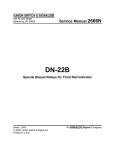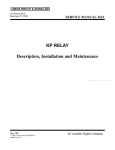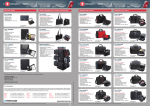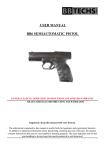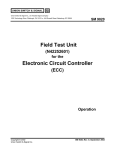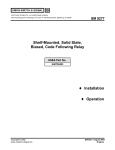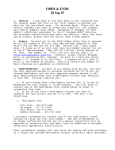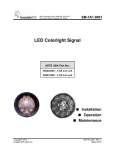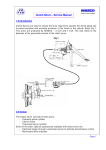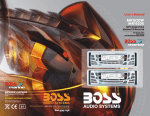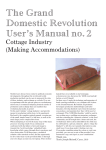Download SM-2666J - Ansaldo STS | Product Support
Transcript
IUNION SWITCH & SIGNAL 645 Russell Street Batesburg, SC 29006 I~ Service Manual 2666-J DN-22B Standard Biased Relay Service Manual July, 1965 B0.59-~00-1009.3 · © 1976, Union Switch & Signal Inc. Printed in U.S.A. I An ANSALDOI Affiliated Company WRBCC ~ SERVICE SPECIFICATION su . 2666-J ~ DN-22B STANDARD BIASED RELAY ******************** (For other information see Service Spec. SU-2666) The relays of this service specification are similar to standard DN-22 relays covered by Service Specification SU-2666, but a permanent magnet is used to hold down the neutral armature when the relay is deenergized or energized with reverse polarity. Due to the space taken by the permanent magnet, front contacts are used only in the outer contact spaces. Service Specification SU2666 (standard DN-22 relay) instructions apply to DN-22B standard biased relays except as otherwise specified herein. ARMATURE AIR GAP The armature air gap should be adjusted as closely as possible to 0. 018 11 parallel (0. 019" if the rust protective coating has been removed from the pole faces). The physical air gap after painting should not be less than 0. 017". If it is necessary to repaint the pole faces, we recommend that Union Pole Face Treatment per Instruction Pamphlet U-5038 be used. This pamphlet also covers an aluminum paint material for touching up armatures, backstraps and similar parts. PERMANENT MAGNET A. Permanent magnets should be removed from relays being repaired then fully charged in the charger as shown in Fig. 1 and immediately assembled to the relay. The magnets must not be stored or handled after charging except to apply to the relay. The magnet should be placed on the charger core with the "N" face up as shown in the diagram. The 2-hole face on the "N" side should attract the end of a compass needle which points toward geographic South. B. Assemble the permanent magnet to the relay and adjust, using a spacer 0. 075" thick at the main upper stop-pin so that the magnet just clears the armature lower stop-pin. For this adjustment do not energize the relay to hold the armature against the spacer but hold it manually so as to bring the armature as close to the pole pieces as the spacer and the pivot clearance will permit. The spacer used for adjustment may be changed between the limits of 0. 065" to O. 090" ~ PRINTED IN U.S.A. BO. 59-300-1009. 3 UNION SWITCH & SIGNAL DIVISION Westinghouse Air Brake Company PITISBURGH, PA. 15218 ~ July 1965 if necessary to meet calibration requirements. With the adjusting spacers removed and the armature released, the armature lower stop-pin should rest on the permanent magnet shoe with at least 50% of its area. "x" 11)(. II I I I I I I "x" ~K SOFT IRON FILLER CORE 7" 'i MIN. DIAMETER NOTE+ THERE MUST BE NO GAPS IN JOINTS AT 11 1 POINTS X~ Charger illustrated is Pc. UN248674, for DP-25 relay magnets, modified with the filler core. Charger for DP-14 relay magnets may be used if similarly modified and proper polarity of charge is observed. FIGURE 1 The air gap between the plated armature and the plated permanent magnet should average 0. 004" but should be not less than O. 003" at any point. The magnet must be securely clamped and the screws properly locked with the sheet metal washer provided. CONTACT ADJUSTMENT - Per Service Spec. SU-2666 except as follows: A. Front contacts should be adjusted using a 0. 035" normal spacer at the main stop-pin instead of 0. 033". A change in spacer is permissible if needed, to meet calibration requirements but it should not be necessary to decrease the spacer below 0. 030". B. Back contacts should be adjusted to all make together and to have at least 0. 020" opening when the front contacts are just making. This can be accomplished if desired, by adjusting them with a spacer at the stop-pin 0. 014" thicker than that used for adjusting the front contacts. Thus, if a 0. 035" spacer has been used for adjusting the front contacts, a 0. 049" spacer should be used for the back contacts. A check must be made to see that, with a 0. 016" thick spacer between the permanent magnet and the stop-pin on the underside of the armature, the back contacts remain closed. C. Bridging contact (when used) front spring should be adjusted the same as standard front contacts as explained in (A) under Contact Adjustment. The back SU-2666-J, p. 2 contact should be adjusted the same as standard back contacts except the spacer used should be 0. 013" thinner than that used for front contact adjustment. This means that if a 0. 035" spacer is used to adjust the front contact, a 0. 022" spacer should be used to adjust the back contact to just open. A spacer 0. 001" thicker than that used for this adjustment should allow the back contact to close. With the armature against the stop pin the bridging back contact opening must be at least 0. 025". CALIBRATION A. Before Calibrating, the relay should be energized at the Charge value given in Table 1 or 2, and the energization pole-changed several times, allowing the current to build up to full value in each direction. When the positive power lead is connected to the "+,, coil terminal, the armature should pick up. When tlte polarity of the power supply is reversed so that the negative power lead is connected to the "+" coil terminal, the armature must not pick up. B. Drop-Away - The relay should be energized at the Charge value with normal polarity and the current then gradually reduced until the armature drops away, opening all front contacts. This value shall be not less than that specified in Table 1 or 2 for "Drop-Away". The current should be further reduced gradually until the back contacts are fully compressed with the armature against the permanent magnet shoe. The energization at which this occurs shall be not less than the table value for DropAway for Full Back Contact Pressure. C. Pick-Up - Immediately after the drop-away value has been measured, the current shall be reduced to zero, the circuit opened for one second and then closed, gradually increasing the current until the armature moves away from the permanent magnet with a very definite sudden motion. This value shall be not more than 90% of the actual pick-up value measured on the tested relay. The current shall then be further increased until the armature picks up and the front contacts make. This value shall be not greater than that specified in Table 1 or 2 for "Pick-Up". D. Working - This value shall be obtained immediately after pick-up by further increasing the current until the armature completes its motion and closes against the stop-pin. This value shall be not greater than that specified in Table 1 or 2 for "Working". SERVICE TESTS It is recommended that the following calibration limits be used to determine when relays should be removed from service. 1. When the drop-away of iine relays falls below 67% of table value; or when the drop-away of track relays falls below 85% of table value. 2. When the drop-away for full back contact pressure falls below 25% of the table value. 3. When the pick-up increases above 110% of the table value. For field tests it is satisfactory if the armature picks up directly from the permanent magnet providing the 110% allowance is not exceededo 4. When the working is above 110% of the table value. SU-2666-J, p. 3 WABCO ~~ CHECK OF PERMANENT MAGNET A. Reverse Pick-Up - The armature shall not pick-up or move away from the permanent magnet when the relay is energized with a reverse polarity energization (negative lead on the "+" coil terminal) equal to four times the pick-up value in Table 1 or 2. B. Hold-Down Torque .. With the relay in the normal upright position and with the coils deenergized, a force of 100 grams, applied on the front edge of the full thickness portion of the armature, shall be required to cause the armature to move away from the permanent magnet. This check shall be made after energizing the relay at the Charge value with normal polarity of energization. TABLE NO. 1 CALIBRATION VALUES FOR DN-22B TWO-POINT ORDINARY ACTING RELAY WITH L. V. CONTACTS. SMALL BACK STRAP. ARMATURE AIR GAP =0. 019 11 PARALLEL Re sis. per- pair of Coils Ohms 0.5 l* 2 4 10 16 24 40 55 90 100 150 250 360 500 670 1000 1500 2000 Min. Drop-Away Charge Amps. 0.73 0.52 0.37 0.26 0.17 0.135 0.112 0.083 0.070 0.059 Volts 5. 6 6.8 9.2 11.1 12. 3 15.1 18. 6 23.2 27.4 with Contact Pressure Amps. Volts 0.106 0.053 0.074 0:074 0.106 0.053 r.037 0.148 0.024 0.24 0.0192 0.31 0.0160 0.38 0.0118 0.47 0.0099 0.545 0.0084 0. 76 0.0080 0.0065 0.0052 0.0044 0.0035 0.0032 0.0026 0.0022 0.0019 0.80 0.97 1. 31 1. 58 1. 76 2.14 2.64 3.30 3.90 Min. D.A. Full Back Cont. Press. Amps. 0.069 0.0495 0.035 0.025 0.016 0.013 0.0107 0.0079 0.0066 0.0056 Volts o. 53 0.65 0.88 1.06 1.17 1. 43 1.77 2.20 2. 61 Max. Pick-Up & Working (Full Stroke) Amps. Volts 0.093 0.186 0.130 0.130 0.186 0.093 0. 260 0.065 0.43 0.043 0.54 0.0338 0.67 0.0280 0.0207 0.83 0.975 0.0174 0.0148 1.33 0.0140 o. 0113 0.0092 0.0077 0.0062 0.0056 0.0047 0.0039 0.-0034 1. 40 1. 70 2.30 2.78 3.09 3.76 4.65 5.80 6.86 * Coils are connected in multiple. TABLE NO. 2 CALIBRATION VALUES FOR SPECIAL DN-22B TWO-POINT ORDINARY ACTING RELAY WITH L. V. CONTACTS AND LARGE BACKSTRAP. ARMATURE AIR GAP ,. O. 019" PARALLEL Re sis. per pair of Coils Ohms 60 SU-2666-J, p. 4 Charge Amps. 0.073 Min. Drop-Away with Contact Pressure Amps. Volts 0.0104 0.626 Min. D.A. Full Back Cont. Press. Amps. 0.0070 Max. Pick-Up & Working (Full Stroke) Amps. Volts 0.0183 1.10







